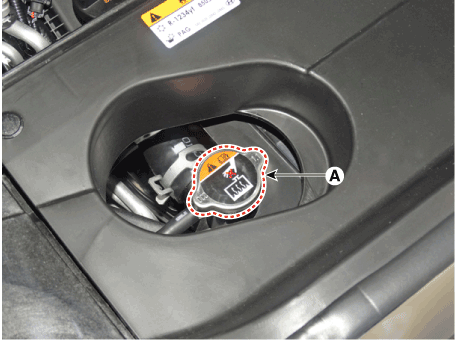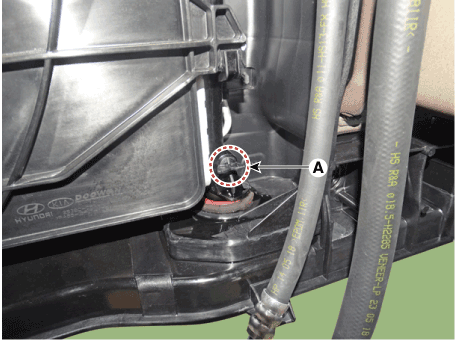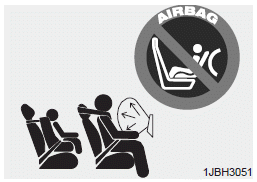Hyundai Palisade: Cooling System / Coolant
Repair procedures
| Replacement And Air Bleeding |
| • |
Be careful not to damage the parts located under the vehicle
(floor under cover, fuel filter, fuel tank and canister) when
raising the vehicle using the lift.
(Refer to General Information - "Lift and Support Points")
|
|
| • |
Never remove the radiator cap when the engine is hot. Serious
scalding could be caused by hot fluid under high pressure escaping
from the radiator.
|
|
| • |
When pouring engine coolant, shut the relay box lid and be careful
not to spill coolant on the electrical parts or the paint. Rinse
off any spilt coolant immediately.
|
|
| 1. |
Make sure the engine and radiator are cool to the touch.
|
| 2. |
Remove the radiator cap (A).

|
| 3. |
Remove the engine room under cover.
(Refer to Engine and Transaxle Assembly - "Engine Room Under Cover")
|
| 4. |
Loosen the drain plug (A), and drain the coolant.

|
| 5. |
Tighten the radiator drain plug securely.
|
| 6. |
Remove, drain and reinstall the reservoir. Fill the tank halfway to
the MAX mark with water, then up to the MAX mark with antifreeze.
|
| 7. |
Fill the radiator with water through the radiator cap and tighten the
cap.
| •
|
To most effectively bleed air, pour water slowly while
pressing on the upper / lower radiator hoses..
|
|
|
| 8. |
Start the engine and allow it to warm up to normal operating temperature.
Wait until the cooling fans turn on 2-3 times. Accelerate the engine
to aid in purging trapped air. Shut the engine off.
|
| 9. |
Wait until the engine is cool.
|
| 10. |
Repeat steps 1 to 8 until the drained water runs clear.
|
| 11. |
Fill with fluid mixture of coolant and water (45-60% or 45-50% in North
America, Europe and China) slowly through the radiator cap.
Push the upper/lower hoses of the radiator so as to bleed air easily.
| •
|
Use only the specified antifreeze/coolant.
|
| •
|
For best corrosion protection, the coolant concentration
must be maintained year-round at 45 - 60% minimum.
Coolant concentrations less than 45 - 60% may not provide
sufficient protection against corrosion or freezing.
|
| •
|
Coolant concentrations greater than 60% will impair
cooling efficiency and are not recommended.
|
|
| •
|
Do not mix different brands of antifreeze/coolants.
|
| •
|
Do not use additional rust inhibitors or antirust products;
they may not be compatible with the coolant.
|
|
|
| 12. |
Start the engine and run until coolant circulates.
|
| 13. |
When the cooling fan operates and coolant circulates, refill coolant
through the radiator cap.
|
| 14. |
Repeat step 11 until the cooling fan operates 3-5 times to sufficiently
bleed air out of the cooling system.
|
| 15. |
Install the radiator cap and fill the reservoir tank to the "MAX" (or
"F") line with coolant.
|
| 16. |
Run the vehicle under idle until the cooling fan operates 2-3 times.
|
| 17. |
Stop the engine and wait for the coolant to cool down.
|
| 18. |
Repeat steps 10 to 15 until the coolant level doesn't fall anymore to
bleed air out of the cooling system.
| •
|
Bleed air out of the cooling system and refill coolant
after the coolant has cooled down completely. To do
this, recheck the coolant level in the reservoir tank
2-3 days after replacing coolant.
|
|
|
Coolant capacity :
Approx. 11.98 L (3.16 U.S.gal., 12.66 U.S.qt., 10.54 lmp.qt.)
|
|
Engine Overheat Troubleshooting
Inspection
Remedy
Visual inspection
Inspect for shortage of coolant in reservoir tank ...
Other information:
Repair procedures
Replacement
[C-MDPS]
1.
Turn the ignition switch OFF and disconnect the battery negative (-)
cable.
2.
Turn the steering wheel so that the front wheels are placed in the straight
ahead position...
Components and components location
Components Location
1. AWD
ECU
2. Luggage side
trim [Left side]
Description and operation
Description
The AWD ECU distributes the driving force to the front/rear wheel through controlling
the multi plate clutch on the AWD transfer case by analyzing the input information,
i...
Categories

Even though your vehicle is equipped
with the OCS, never install a child
restraint in the front passenger's seat.
An inflating air bag can forcefully
strike a child or child restraint resulting
in serious or fatal injury.
read more
 Troubleshooting
Troubleshooting Cooling Fan
Cooling Fan









